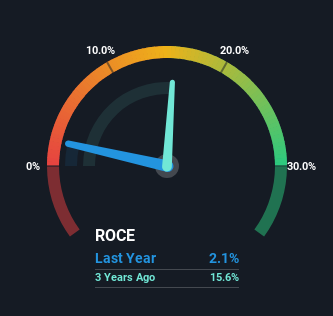Capital Allocation Trends At Wankai New Materials (SZSE:301216) Aren't Ideal
What trends should we look for it we want to identify stocks that can multiply in value over the long term? Amongst other things, we'll want to see two things; firstly, a growing return on capital employed (ROCE) and secondly, an expansion in the company's amount of capital employed. If you see this, it typically means it's a company with a great business model and plenty of profitable reinvestment opportunities. However, after briefly looking over the numbers, we don't think Wankai New Materials (SZSE:301216) has the makings of a multi-bagger going forward, but let's have a look at why that may be.
What Is Return On Capital Employed (ROCE)?
Just to clarify if you're unsure, ROCE is a metric for evaluating how much pre-tax income (in percentage terms) a company earns on the capital invested in its business. The formula for this calculation on Wankai New Materials is:
Return on Capital Employed = Earnings Before Interest and Tax (EBIT) ÷ (Total Assets - Current Liabilities)
0.021 = CN¥166m ÷ (CN¥13b - CN¥5.6b) (Based on the trailing twelve months to March 2024).
Thus, Wankai New Materials has an ROCE of 2.1%. In absolute terms, that's a low return and it also under-performs the Chemicals industry average of 5.5%.
Check out our latest analysis for Wankai New Materials

Above you can see how the current ROCE for Wankai New Materials compares to its prior returns on capital, but there's only so much you can tell from the past. If you'd like to see what analysts are forecasting going forward, you should check out our free analyst report for Wankai New Materials .
What Does the ROCE Trend For Wankai New Materials Tell Us?
In terms of Wankai New Materials' historical ROCE movements, the trend isn't fantastic. Over the last five years, returns on capital have decreased to 2.1% from 36% five years ago. On the other hand, the company has been employing more capital without a corresponding improvement in sales in the last year, which could suggest these investments are longer term plays. It's worth keeping an eye on the company's earnings from here on to see if these investments do end up contributing to the bottom line.
On a related note, Wankai New Materials has decreased its current liabilities to 42% of total assets. That could partly explain why the ROCE has dropped. Effectively this means their suppliers or short-term creditors are funding less of the business, which reduces some elements of risk. Since the business is basically funding more of its operations with it's own money, you could argue this has made the business less efficient at generating ROCE. Keep in mind 42% is still pretty high, so those risks are still somewhat prevalent.
The Bottom Line On Wankai New Materials' ROCE
Bringing it all together, while we're somewhat encouraged by Wankai New Materials' reinvestment in its own business, we're aware that returns are shrinking. Since the stock has declined 36% over the last year, investors may not be too optimistic on this trend improving either. In any case, the stock doesn't have these traits of a multi-bagger discussed above, so if that's what you're looking for, we think you'd have more luck elsewhere.
Since virtually every company faces some risks, it's worth knowing what they are, and we've spotted 4 warning signs for Wankai New Materials (of which 2 are potentially serious!) that you should know about.
While Wankai New Materials may not currently earn the highest returns, we've compiled a list of companies that currently earn more than 25% return on equity. Check out this free list here.
Valuation is complex, but we're here to simplify it.
Discover if Wankai New Materials might be undervalued or overvalued with our detailed analysis, featuring fair value estimates, potential risks, dividends, insider trades, and its financial condition.
Access Free AnalysisHave feedback on this article? Concerned about the content? Get in touch with us directly. Alternatively, email editorial-team (at) simplywallst.com.
This article by Simply Wall St is general in nature. We provide commentary based on historical data and analyst forecasts only using an unbiased methodology and our articles are not intended to be financial advice. It does not constitute a recommendation to buy or sell any stock, and does not take account of your objectives, or your financial situation. We aim to bring you long-term focused analysis driven by fundamental data. Note that our analysis may not factor in the latest price-sensitive company announcements or qualitative material. Simply Wall St has no position in any stocks mentioned.
About SZSE:301216
Wankai New Materials
Engages in the research and development, production, and sale of polyethylene terephthalate (PET) materials.
Slight risk and slightly overvalued.
Market Insights
Community Narratives



